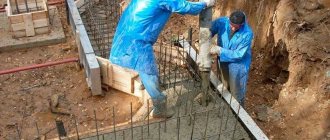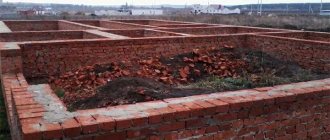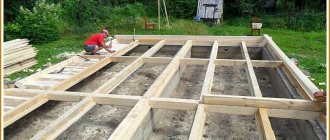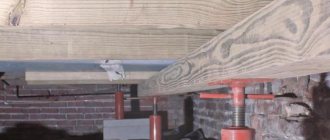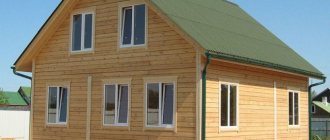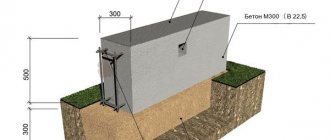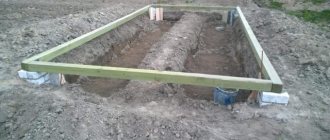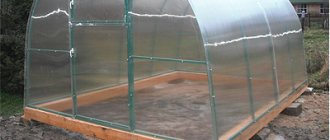You can often find old wooden houses that do not stand on a foundation, since previously the house was installed on wooden supports, which were tarred logs. And of course, over time they collapse, and the foundation has to be changed, and the foundation will need to be laid under an old wooden house. How to do it?
An example of pouring a new foundation for an old wooden house
Methods of restoration and replacement
After assessing the destruction of the foundation, it is restored or completely replaced. Each technology requires adherence to a certain sequence recommended by experts.
Strengthening. Minor damage to the strip foundation can be eliminated by pouring a new concrete layer around the perimeter. Restoration is carried out according to the following scheme:
- A trench is dug along the perimeter of the house, deep to the bottom of the foundation.
- The soil is removed from the brickwork with a metal brush.
- Holes are drilled in the old base and reinforcement is inserted into them.
- A mesh harness is welded to the clogged reinforcement, which will serve as the basis for the concrete pour. To ensure reliable adhesion, the mesh is screwed to the reinforcement with wire.
- Formwork is installed along the perimeter of the foundation and filled with concrete. Filling is carried out in layers, in small sections no more than 2 meters in length. After each poured layer, the concrete is allowed to soak into the soil and base.
After strengthening, the concrete will firmly bond with the old foundation and soil, the house will receive additional support area, will stop deforming, and the foundation will stop collapsing.
Construction rules
Tape
Such a foundation is made of brick, cinder block, rubble stone, reinforced concrete blocks or monolith. It should run as a continuous strip under all structures of the building. This is necessary to ensure that the weight is evenly distributed over the entire surface of the base. The masonry is carried out using cement-sand mortar, the height of the foundation should be from 50 to 80 cm, with 30 cm falling on the buried part, and 20-50 on the above-ground part.
If the area is heavily flooded, then the basement part can be made higher.
To fasten the crown of a wooden house, threaded rods or side angles are installed in the foundation. Then a grid of reinforcement, smooth metal rods, thick iron wire or small pipes is installed. The grating is laid on the bottom of a pre-prepared trench in two rows at a distance of about 10 cm from the formwork, while the distance between the rods should be approximately 50 cm. The rods must be fastened together by welding or tying them with wire.
Depending on the depth of occurrence, it can be:
- deep-seated - for massive multi-story structures;
- shallow - for a one-story wooden house;
- not buried - for light outbuildings.
Columnar
This type of foundation is chosen if the upper layers of soil on the site cannot provide reliable support for the strip foundation. The pillars are made of brick, blocks or reinforced concrete. Their width should be about 20-30 cm greater than the thickness of the walls of the house, and their height should be 3 times the width. Most of the height of the pillars is usually in the above-ground part.
The distance between the foundation pillars along the perimeter of the house should be 2-2.5 meters, and they must be installed at open or closed corners of the house, intersections and convergences of internal walls.
The technology for constructing a columnar foundation for a wooden house involves several stages:
- creating a diagram of the arrangement of pillars;
- preparing a trench around the perimeter of the house;
- concreting pits;
- installation of studs and corners for mounting the first crown;
- laying a waterproofing layer on the sections of the pillars.
The upper part of the foundation pillars is connected by horizontal reinforced concrete beams, which form the base of the house.
Pile
Such a base can be installed at any time of the year. It is perfect for moving soils, is fast and inexpensive to install. There are two types of pile foundations.
Bored
To install it, you will need to drill several holes in the ground with a diameter of approximately 20 cm at a distance of 2 m from each other. In this case, it is important to install piles at the open and closed corners of the building’s perimeter, at the points of convergence and intersection of its walls. Then it is necessary to lower asbestos-cement pipes of the appropriate size into the prepared holes and level the height of the pipes to the required parameters. After this, three reinforcement bars should be lowered into the pipe and filled with concrete. All that remains is to install the threaded rods and anchors on the upper end of the structure.
Screw-in
Its design involves screwing piles into the ground to the required depth. Piles can be screw piles, made of iron pipes with a head, blades and a tip.
Dismantling the old base and installing a new one
So, the house is raised, now it is necessary to remove the old frame.
So, the house is raised. Now you need to remove the old frame. To do this, use a chisel, a hammer drill and other complex powerful equipment. We are not in a hurry to throw away waste from the old foundation. They will still come in handy.
As soon as the old frame is removed, you can begin to form a pit for a new one. To do this, you can deepen the existing one a little or simply install a durable sand cushion 20 cm thick if the trench is deep enough. The sand is slightly moistened and compacted well.
- Formwork is installed in the trench, taking into account the bypass of those places where jacks and support posts are located. These holes can later be simply filled with bricks.
- A reinforcing belt is placed in the formwork, and care is taken that in the corners of the house it is bent and not welded. Since it is the corners of the building that will be responsible for the strength of the entire frame.
- The solution is poured into the prepared formwork and waited for it to dry completely.
- As soon as the concrete has dried, the crown logs are replaced if necessary. They can be tapped for rotting. If, when you knock on a log, it emits a ringing hum, then the wood is good. If the log has a dull echo, it means that it is rotting inside and requires replacement.
- Logs are replaced down to those that are well preserved.
Upon completion of all work, the house is also simultaneously and gradually lowered onto a new foundation. Windows, doors, floors and roof are returned to their place. The new foundation is sprinkled with the remains of the broken old foundation and compacted with soil.
A wooden log house is ready for use for another 30-40 years, provided that the wood is well cared for.
Factors that indicate the need for foundation repair or replacement
Before starting restoration work, it is necessary to understand why the foundation was destroyed, how serious the damage is, and also determine how the damaged building can be reconstructed.
Brick foundation that requires complete replacement
Causes of damage to the foundations of wooden houses
To prevent a similar problem in the future, it is necessary to understand the factors that lead to the destruction of the foundation. And this happens for several reasons:
- geological and hydrological changes that lead to subsidence or displacement of the soil under the building;
- violation of construction technology and use of low-quality materials;
- absence or improper operation of the drainage system;
- time factor - even high-quality materials lose their performance properties over the years;
- weighting of the structure due to additional superstructures.
It is quite simple to determine whether the house is currently subsiding or whether the foundation has found new support points. To do this, beacons made of plasterboard or paper are installed in the busiest places. Their damage indicates that the destruction process is continuing.
What are the types of deformations?
The second thing that needs to be done during the research process is to determine the degree of destruction. The complexity of restoration work depends on this factor. Conventionally, 4 types of deformations can be distinguished:
- Small defects that manifest themselves in the peeling of the foundation finishing. As a rule, the strength of the foundation does not suffer from this, and problems can be eliminated without any problems.
- Moderate damage, indicated by cracks in the base that appear as a result of its displacement. To reveal how much the foundation subsidence is progressing, a layer of putty is applied to the problem area. A crack that appears at the slightest deformation can tell about the rate of deformation, as well as its nature and direction of displacement.
- Significant or catastrophic damage resulting from significant subsidence, displacement, or failure of the foundation. They are revealed in the violation of the geometry of the walls, the appearance of large gaps between the crowns, and the warping of windows and doors. Problems of this kind lead to the impossibility of operation or complete destruction of the house, so urgent reinforcement or replacement is necessary.
- Unavoidable consequences. If the moment is missed, then repairing the house will most likely be unprofitable. In this case, a decision is made to demolish the building and build new housing.
After carefully analyzing the nature and extent of destruction, a decision is made on how to reconstruct the foundation. If deformations can be eliminated and prevented in the future, then the foundation can be strengthened. Otherwise, it will need to be completely replaced.
In some cases, it is not practical to renovate a house - it is easier to build a new one
Reasons for deformation of the structure
Subsidence of the base tape entails distortion of the load-bearing walls of the building and its inevitable destruction. An analysis of the factors that influenced the appearance of cracks in load-bearing structures will make it possible to find out the reasons for the deformation of the foundation.
Conditions for reducing the strength of the foundation include:
- Change in load: increasing the number of floors, adding premises, installing heavy equipment;
- The appearance of aquifers in the soil and, consequently, an increase in pressure during frost swelling of the soil;
- The influence of long-term precipitation on the physical properties of soil;
- Structural errors during construction: insufficient base area and laying depth;
- Low quality of concrete and violation of its laying technology;
- Deterioration of the waterproofing layer due to the lack of a blind area, basement flashings and a rainwater drainage system.
Taking into account the objective causes of settlement, it is necessary to assess the degree of deformation of the house and draw up an estimate for repair work.
We prepare and pour the foundation for an old house
Everyone has seen at least once in their lives houses with deep cracks and warped walls.
And it doesn’t matter at all whether the old house is made of brick or wood, it’s still possible to make a new foundation
To solve this problem, you can do several things:
- Completely replace the foundation.
- Strengthen the existing foundation.
- If there is no foundation at all, raise the house onto the foundation.
It is clear that these methods are radically different in terms of complexity. To understand how much, you can watch a video of pouring the foundation for a house with your own hands on the Internet.
Let's take a closer look at each of the methods of pouring the foundation for a house.
Complete replacement of the foundation under an old house
In this case, there is no other choice but to take up the arrangement of a reinforced strip foundation. To do this, the old timber house is raised using large jacks, the old destroyed foundation is dismantled and a new one is poured. Let's talk in more detail about all these works.
Raising the house
If it is not clear how to raise the house to pour the foundation, you just need to support the corners of the old wooden house. Then you need to raise those corners of the building that sag the most. For work, it will be enough to take or rent 2 jacks capable of lifting weights up to 5 tons. When one corner is raised, a wooden block or thick piece of metal is immediately placed.
It is important that when raising the sides of an old house, cracks do not appear. Therefore, you should not lift more than 20 mm
By the way, you don’t need to trust the jack 100%. To be sure, it is better to place wooden blocks under the walls every 5 mm.
Gradually it will be possible to raise the entire structure to the desired height. Install a few extra supports under the longest sides of the house, thereby protecting the builders from a possible fall.
Replacement
This stage of replacing the foundation for a house is carried out using the following technology:
- The old foundation is dismantled in its corners, we fill the base with medium grade crushed stone and only then the footing is poured.
- Then the reinforced frame is prepared. A concrete structure with it will have high strength. Do not forget to tie the reinforcement cage together, plus release the reinforcement slightly from under the base.
- Then you can make the formwork.
- While pouring concrete, use a vibrator to force out any air pockets.
- When the poured concrete dries, the remaining sections of the old foundation are dismantled and filled with new concrete, and so on until the entire foundation is replaced. In other words, it is possible to completely replace the old foundation with a new one only in separate parts. That is why it is more rational to divide the entire perimeter of the house by 2 meters. It is imperative to carry out concrete work through one segment. This will significantly increase occupational safety.
Until the foundation has hardened sufficiently, the house cannot be lowered.
Making a new foundation if there is no foundation under the old house at all
It is highly not recommended to pour the foundation for a house without reinforcement, since the foundation will not be strong and will collapse over time.
It may turn out that an old private house does not have any foundation. Then you need to “wrack” your brain on how to lift it onto the foundation without damaging it. Usually, old wooden huts were built without a foundation.
Technology for raising a house to its foundation
- You need to dig a trench along the entire perimeter using a spade bayonet (25 cm).
- Then logs or reinforced concrete piles should be installed under the bottom of the wooden house.
- The dug trench is filled with crushed stone to a height of 15 cm.
- Then the formwork is made from the inside under the house.
- Then you can move on to arranging it using metal frame reinforcement.
- Then you can make formwork on the outside (it is made a little higher). This will make it possible to add concrete when the formwork has already been removed.
- Adding fine crushed stone and further pouring concrete.
Strengthen the existing foundation of an old house
If the building already has an old foundation, it can be strengthened. In other words, you need to pour a new portion of concrete under the foundation of the old house. You need to follow these steps:
A trench is being dug around the perimeter of the house. Reinforcement is driven into the old foundation. But at the same time, it is necessary not to damage the existing foundation. After the problems are eliminated, the trench is filled with concrete
It is important that the concrete mixture penetrates into all holes in the old foundation.
Pouring concrete solution
Pouring concrete solution
It takes about a month to strengthen the foundation
Video - Do-it-yourself foundation for a house
Nikolay Zhuravlev chief editor
Author of publication 02/27/2015
Did you like the article? Save so you don't lose!
Complete replacement of the house foundation
Using the house hanging method, the old foundation is removed and a new one is installed.
- It is necessary to reduce the load on the foundation as much as possible. To do this, you need to completely empty the house of all heavy things and furniture. In other words, leave only the supporting frame.
- The load of the house is calculated. To do this, you need to obtain data on the density of wood, its quantity used and the final mass. As a rule, the floors in such wooden houses are also made of wood and are lightweight. But even this must be taken into account.
- Special construction jacks are purchased or rented, which can temporarily replace the main foundation and take on the entire load.
- Trenches are dug under them. Even if water appears in the trench, it is not fatal, because the boundary level of groundwater rise will immediately be revealed.
- Then the jacks are brought in, installed under the base of the house and carefully and evenly raise it.
- The condition of the lower parts of the house is being analyzed. If the deformation does not affect them, then you can begin to dismantle or repair the base itself.
- To do this, a sand and gravel cushion is made, on which concrete or brick supports are installed at the corners of the building and at the intersection of load-bearing walls. It is also possible to install new piles, but this is only possible if there is sufficient space on the construction site.
- After installing the new foundation, the entire structure is reinforced. here it is advisable to create a flexible connection with the old foundation, if its complete dismantling is not envisaged.
- Formwork is installed into which concrete is poured. After the concrete has dried, the new base is waterproofed.
- Only after a few days is the air released from the jacks evenly and simultaneously, and the building is lowered onto a new foundation. If desired, finishing work can be carried out.
What can you do to avoid future damage?
The reliability and durability of the foundation depend not only on its design and compliance with climatic conditions and soil characteristics, but also on proper hydro- and thermal insulation.
The cause of most problems associated with foundation subsidence are errors associated with choosing the depth of its underground part. Foundations whose base is below the soil freezing level require restoration or restoration work much less often than shallow foundations. At the same time, certain types of soil (for example, peat) require reclamation measures or the excavation of unsuitable earthen soil and subsequent replacement with imported soil.
An important detail on which the safety of the foundation depends is proper waterproofing. Since the foundation is affected not only by wet soil, but also by atmospheric influences, the waterproofing system must be ensured by:
- wide blind area;
- vertical and horizontal waterproofing;
- effective drainage.
For wooden houses without basements, only horizontal protection against moisture penetrating into the wood will be sufficient.
High-quality waterproofing will protect the foundation from the damaging effects of moisture
For these purposes, Bicroelast, Akvaizol, Bipol and other rolled materials are used, which are laid between the foundation and the lower crowns. Waterproofing is laid in 2-3 layers along the edge of the foundation.
Vertical waterproofing prevents moisture from penetrating into the basement of a wooden house. It is applied both to the outer surface of the foundation and on both sides. In this case, insulation work is carried out in several ways:
- installation of roll or film materials on a layer of mastic;
- coating the surface with a bitumen-rubber or bitumen-polymer mixture;
- installing geotextile membranes or arranging waterproof locks using bentonite clay panels;
- applying penetrating cement-polymer compositions.
Special attention is paid to the drainage system - it should ensure water drainage no closer than 2–3 m from the extreme point of the foundation. If the walls of the basement suffer from excessive moisture and fungi, then in addition to waterproofing, the base of the building is also insulated. For this, special waterproof boards are used, which are glued to a layer of bitumen mastic and then sealed using plastic protective materials.
For this, special waterproof boards are used, which are glued to a layer of bitumen mastic and then sealed using plastic protective materials.
If the walls of the basement suffer from excessive moisture and fungi, then in addition to waterproofing, the base of the building is also insulated. For this purpose, special waterproof boards are used, which are glued to a layer of bitumen mastic and then sealed with plastic protective materials.
General principles for strengthening the foundation
Strengthening the foundation along the perimeter: 1. sand cushion; 2. old foundation; 3. metal mesh; 4. anchor; 5. place of destruction; 6. formwork; 7. concrete.
Before you begin strengthening the foundation, it is necessary to conduct a thorough inspection of it. It may well turn out that initially the foundation of the building was laid with a large margin of safety, with the expectation of erecting the next floor. In this case, you are very lucky. But it also happens that the existing foundation raises many questions about the adequacy of the builders and their professionalism. Many amateur builders who are building a house for themselves or relatives without the involvement of specialists may well ignore full calculations, thinking that it will do just fine. Therefore, the stage of inspection, identification of damage and carrying out calculations is exactly where it is necessary to begin even before directly strengthening the foundation of the house.
Having completed the first stage, it is necessary to strengthen the walls. This work is carried out using both external and internal supports. It is also necessary to take into account the fact that if the house has a ground floor or basement, and you plan to deepen the building, then such work requires a scrupulous attitude. This is due to the fact that as soon as you start digging a trench along the entire length of the building before strengthening it, the load on the walls will be significantly increased and this can lead to its complete destruction. Therefore, when you start strengthening the foundation, under no circumstances immediately dig such a trench, do not expose it.
What should you do if such a continuous trench cannot be dug? This can be done gradually. To do this, you first need to excavate certain areas along the foundation of the old house. The distance between these areas should be 1 m.
Basic methods of foundation repair and strengthening.
It is necessary to dig from the corners of the old house. You need to continue digging in those places where the outer and inner walls connect. After this, an excavation is made along the entire length of the old building. At the same time, it is necessary to clean out the excavation areas as well. If it is planned to concrete a new foundation, it is necessary to provide small gaps of up to 30 cm between the new and old foundations of the building.
After the excavations have been made, it is necessary to build pits under the buildings. Reinforcement is placed in them and concrete is poured. The concrete solution must be thick and when pouring it, it is necessary to ensure that it evenly and sufficiently fills the space under the base of the building. To do this, you need to use professional equipment, in this case it is a good vibrator. After the work on strengthening the foundation is completed, it is necessary to build a blind area around the building up to 60 mm high from the ground, which should reliably protect the foundation from precipitation and floods.
In addition, it is necessary to provide for the strengthening of its walls, which is carried out in a certain sequence. Perimeter walls cannot be reinforced. First, any wall of the house is strengthened along its length, if the house has a rectangular shape. After strengthening this wall, the wall opposite is strengthened. After completing the strengthening of the walls of the house along its length, they proceed to strengthening the walls along its width.
How to replace the base
If the house is already warped, a more serious reconstruction is needed; you will need to add a foundation to the old foundation along the entire perimeter of the building. More serious work will be required: the house will be raised, and then it will be put back on a new foundation structure. What to prepare for work? What tools will you need:
- shovel;
- Master OK;
- hammer;
- jacks, for lifting a weight of at least 5 tons, about 5 pcs.;
- reference apparatus.
Materials:
- gravel;
- sand;
- cement mortar;
- roofing felt;
- bars.
Progress:
- Everything possible is removed from the premises: furniture, equipment. This process is necessary to make the structure lighter; sometimes the floor, doors and windows are dismantled.
- At least 2 beams are placed under the bottom layer of timber; these are temporary supports. Ordinary beams or metal blanks are suitable; their thickness must correspond to the weight of the house, and the length is selected so that they protrude half a meter. To put them in you will have to destroy part of the foundation.
- Next, jacks are installed, and a solid foundation is placed under each of them so that it does not sink into the ground during operation. You can use an iron sheet or a piece of concrete; anything that can withstand the load will do, but in no case will the foundation support itself be suitable.
- Gradually, as the space increases as the building is raised, supports are placed under the base.
- If the walls are long, it is necessary to install additional channels so that the logs do not sag under their own weight.
- The structure is lifted evenly, trying not to create distortions; lift it a centimeter with one tool and move on to the next.
- Work continues until the house rises to the desired height. Usually 8 or 10 cm is enough.
- Then the defective base is dismantled.
After removing the old material, you need to properly add the foundation; there are some nuances here:
- dismantling and filling should begin from the corners;
- The base is replaced in parts of 2 meters through one element.
Filling is carried out according to the usual scheme:
- formwork is being built;
- a cushion of sand and crushed stone is poured;
- the solution is poured.
A small space should be left for laying waterproofing roofing felt. The house can be placed on the foundation after the concrete has completely dried.
Strengthening the foundation of a house on columns
Strengthening the foundation using the drilling method.
The general case discussed above is why, how and in what sequence work is carried out to strengthen the foundation of a building. In particular cases, questions arise about how to carry out such work, i.e. pour the foundation under the old house, which is located on columns. This not only gives the building a more aesthetic appearance, but also strengthens the foundation of the house. In addition, this can make the space under the house warmer, and therefore insulate the entire house.
To strengthen the foundation in such a house, it is necessary to dig a trench between the columns from the outside of the building. The depth of the trench should not exceed the bayonet of a shovel, and its width should be equal to the width of the column. After this, sand is poured into the dug trench to a level of at least 10 cm.
On the inside, which is located under the building, it is necessary to make formwork. To do this, you can mount boards or use chipboard, plywood, edged boards with a thickness of 20-30 mm. The formwork must be secured using racks and stops. This is done so that it does not fail when pouring concrete.
Repair of the foundation of a stone house.
Then, before pouring the concrete, reinforcement must be laid. If possible, secure the reinforcement to column supports. What is suitable as fittings? This can be corrugated reinforcement, mesh, both masonry and cut, steel wire and any scraps that are lying around in the yard.
It is necessary to take into account that the outer side should not be left without formwork. Install it in such a way that the gaps left allow concrete to be poured, and after its removal it would be possible to seal the remaining niche. In cases where the formwork has significant gaps or cracks in its walls, it is necessary to use polyethylene film, securing it with a stapler. This will prevent concrete from spilling through such gaps.
The requirements for poured concrete are such that it should resemble sour cream in terms of viscosity or fluidity. As for crushed stone, use as fine as possible. If the crushed stone is large, voids may form and it will be difficult to compact the concrete.
You can avoid pouring concrete if you make brickwork instead, for which you can use old bricks from already dismantled masonry. This option eliminates the need to make formwork, and the unsightly effect of using old brick is removed by plaster from the outside. If the building has a basement and it is assumed that it will be covered, for example, with siding, then in this case there will be no need for plaster.
But even with brickwork, it is highly recommended to use both steel wire reinforcement and a sand bed. If you neglect this requirement, you can soon get a sad result in which the brick run between the supports may fail. This option is most likely for heaving soils. Don't skimp on this and don't create difficulties for yourself in the near future.
Installation of formwork
Installation of foundation formwork
When installing the formwork you will need:
- edged boards with a thickness of 2 cm or plywood sheets;
- polyethylene film;
- roulette;
- screws or nails;
- hammer and screwdriver;
- bars for spacers.
Strip foundation formwork
Foundation grouting technology
Adding a foundation to an old house requires the use of special tools that will raise the structure while the procedures are completed. The first step is to dig a trench around the perimeter of the house; the process has the following procedure:
- The corners of the building are dug out.
- Ground procedures are carried out at the intersections of walls where it will be necessary to open holes, with dimensions suitable for inspecting structures.
- Then continuous trenches are dug around the base along the perimeter of the house.
To avoid soil shedding, the walls of the pit should have an inclination angle of 30 to 40 degrees. The width of the trench should not exceed 1 m. The depth of the pit should be below the base of the old base.
Preparatory processes for pouring concrete mortar.
The base structure is cleared of adhering soil, its walls are leveled and cleaned. If the wooden building has a columnar base, you will need to dig a hole near each pillar to assess the strength of each support. To increase safety, it is recommended to install special jacks at each corner of the building.

